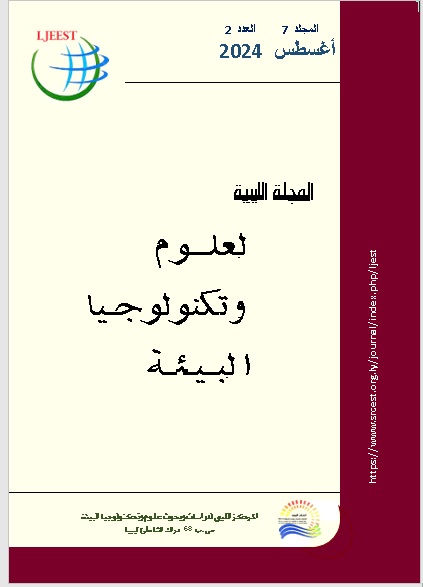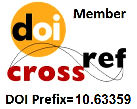نحو استدامة بيئية: استعراض شامل لمعالجة التلوث بالمعادن الثقيلة في التربة والمياه بالطرق الكهروكيميائية - إنجازات وتحديات وآفاق
DOI:
https://doi.org/10.63359/qrhp5b40الكلمات المفتاحية:
المعالجة الكهروكيميائية، المعادن الثقيلة، معالجة التربة، معالجة المياه، اليات ازلة الملوثات، مواد الاقطاب الكهربائيةالملخص
يشكل التلوث بالمعادن الثقيلة في التربة والموارد المائية تهديدات خطيرة للاستدامة البيئية والصحة البشرية. برزت تقنيات المعالجة الكهروكيميائية (ERT) كمناهج واعدة ومتعددة الاستخدامات لمعالجة هذا التلوث. يستعرض هذا المقال التحليلي الحديث الآليات الأساسية الداعمة للمعالجة الكهروحركية (EKR) للتربة والمعالجة الكهروكيميائية (ECT) للمياه، بما في ذلك: الهجرة الكهربائية، التناضح الكهربائي، الرحلان الكهربائي، وردود الفعل الأكسدة-الاختزال الإلكتروليتية عند الأقطاب. نقدم أحدث التطورات في تطبيقاتها لإزالة المعادن الثقيلة الشائعة مثل: الرصاص Pb، الكادميوم Cd، الكروم Cr، الزرنيخ As، النحاس Cu، الزنك Zn، الزئبق Hg.يُسلط الضوء على التطبيقات الحقلية والنظم الهجينة (مثل: الدمج مع الحواجز التفاعلية النفاذة، المعالجة النباتية، أو التعزيز الكيميائي)، مما يظهر كفاءة محسنة وملاءمة أوسع للتطبيق.رغم التقدم الملحوظ، لا تزال تحديات حرجة قائمة في التوسع النطاقي، تشمل: تحسين استهلاك الطاقة، إدارة عدم تجانس التربة والتدفقات الجوفية، استقرار الأقطاب الكهربائية والتكلفة، إدارة النفايات الثانوية، والقبول التنظيمي. يحدد هذا الاستعراض الفجوات المعرفية الرئيسية ويقدم توصيات محددة للبحث المستقبلي، مؤكداً على الحاجة إلى: دراسات تجريبية متكاملة، مواد أقطاب متقدمة، دمج الطاقة المتجددة، بروتوكولات قياس أداء موحدة، وتحليلات تقنية-اقتصادية لسد الفجوة بين النجاح المعملي والتطبيقات الحقلية واسعة النطاق.
المراجع
Acar, Yalcin B., and Akram N. Alshawabkeh. 1993. “Principles of Electrokinetic Remediation.” Environmental Science & Technology 27(13):2638–47. doi: https://doi.org/10.1021/es00049a002.
Ali, Hazrat, Ezzat Khan, and Muhammad Anwar Sajad. 2013. “Phytoremediation of Heavy Metals—Concepts and Applications.” Chemosphere 91(7):869–81. doi: 10.1016/j.chemosphere.2013.01.075.
Arora, Vaishali, and Babita Khosla. 2022. “Conventional and Contemporary Techniques for Removal of Heavy Metals from Soil.” in Biodegradation Technology of Organic and Inorganic Pollutants. IntechOpen.
Chowdhury, Farah Noshin, and Md Mostafizur Rahman. 2024. “Source and Distribution of Heavy Metal and Their Effects on Human Health.” Pp. 45–98 in Heavy Metal Toxicity: Human Health Impact and Mitigation Strategies. Springer.
Fernández-Marchante, C. M., F. L. Souza, M. Millán, J. Lobato, and M. A. Rodrigo. 2022. “Can the Green Energies Improve the Sustainability of Electrochemically-Assisted Soil Remediation Processes?” Science of The Total Environment 803:149991. doi: 10.1016/j.scitotenv.2021.149991.
Fertu, Daniela Ionela, Laura Bulgariu, and Maria Gavrilescu. 2024. “SUSTAINABLE USE OF SOME NATURAL MATERIALS AND WASTE FOR THE DECONTAMINATION OF ENVIRONMENTAL COMPONENTS POLLUTED WITH HEAVY METALS.” Environmental Engineering & Management Journal (EEMJ) 23(8). doi: 10.30638/eemj.2024.126.
Ghosh, Mridul, and S. P. Singh. 2005. “A Review on Phytoremediation of Heavy Metals and Utilization of It’s by Products.” Asian J Energy Environ 6(4):214–31.
Ho, Sa V, Christopher Athmer, P. Wayne Sheridan, B. Mason Hughes, Robert Orth, David McKenzie, Philip H. Brodsky, Andrew M. Shapiro, Timothy M. Sivavec, Joseph Salvo, Dale Schultz, Richard Landis, Ron Griffith, and Steve Shoemaker. 1999. “The Lasagna Technology for In Situ Soil Remediation. 2. Large Field Test.” Environmental Science & Technology 33(7):1092–99. doi: 10.1021/es980414g.
Lamma, O. A., A. M. Mohammed, and H. A. A. Aljazwei. 2020. “Studying Altitude Influence on Uludağ Fir Soil Macro Nutrients in Kastamonu.” International Journal of Research in Agronomy 5(1):43–48.
Li, Ruixiang, Jinning Wang, Tian Li, and Qixing Zhou. 2023. “Recent Advances in Improving the Remediation Performance of Microbial Electrochemical Systems for Contaminated Soil and Sediments.” Critical Reviews in Environmental Science and Technology 53(1):137–60. doi: 10.1080/10643389.2022.2040327.
Liu, Jianli, Zhubing Hu, Fangfang Du, Wei Tang, Siting Zheng, Shanzhou Lu, Li-hui An, and Jiannan Ding. 2023. “Environment Education: A First Step in Solving Plastic Pollution.” Frontiers in Environmental Science 11. doi: 10.3389/fenvs.2023.1130463.
Masoud, Abduladheim Masoud Mohamed. 2017. “Kuzey Bakıda Yetişen Karaçamın Bazı Toprak Özellikleri Ile Toprak Organik Karbon ve Toplam Azot Miktarları ve Depolama Kapasiteleri Üzerinde Yükseltinin Etkisinin Araştırılması.”
Mishra, Sandhya, Ram Naresh Bharagava, Nandkishor More, Ashutosh Yadav, Surabhi Zainith, Sujata Mani, and Pankaj Chowdhary. 2018. “Heavy Metal Contamination: An Alarming Threat to Environment and Human Health.” Pp. 103–25 in Environmental biotechnology: For sustainable future. Springer.
Moghimi Dehkordi, Mohsen, Zahra Pournuroz Nodeh, Kamran Soleimani Dehkordi, Hossein Salmanvandi, Reza Rasouli Khorjestan, and Mohammad Ghaffarzadeh. 2024. “Soil, Air, and Water Pollution from Mining and Industrial Activities: Sources of Pollution, Environmental Impacts, and Prevention and Control Methods.” Results in Engineering 23:102729. doi: 10.1016/j.rineng.2024.102729.
Mohamed, A. M., F. A. Abdullah, M. A. Arqeeq, H. Ahallil, A. A. Ahmed, and A. A. Saeid. 2025. “Study of Some Physical and Chemical Characteristics of Different Soils in Some Valleys of Bani Walid Region, Libya.” Archives of Agriculture Sciences Journal 14–28. doi: 10.21608/aasj.2025.417745.
Mohammed, Abduladheim Masood. 2021. “Spatial Change of the Chemical and Physical Properties of the Soil.” Journal of Global Scientific Research 6(4):1274–84.
Ntsomboh-Ntsefong, Godswill, Kingsley Tabi Mbi, and Essubalew Getachew Seyum. 2024. “Advancements in Soil Science for Sustainable Agriculture: Conventional and Emerging Knowledge and Innovations.” Academia Biology 2(3). doi: org/10.20935/AcadBiol6264.
Ormeño-Cano, Natalia, and Jelena Radjenovic. 2024. “Electrochemical Removal of Antibiotics and Multi-Drug Resistant Bacteria Using S-Functionalized Graphene Sponge Electrodes.” Journal of Cleaner Production 470:143245. doi: org/10.1016/j.jclepro.2024.143245.
Page, Mary M., and Christopher L. Page. 2002. “Electroremediation of Contaminated Soils.” Journal of Environmental Engineering 128(3):208–19. doi: org/10.1061/(ASCE)0733-9372(2002)128:3(208).
Pamukcu, Sibel, and J. Kenneth Wittle. 1992. “Electrokinetic Removal of Selected Heavy Metals from Soil.” Environmental Progress 11(3):241–50. doi: org/10.1002/9781119670186.ch13.
Probstein, Ronald F. 2005. Physicochemical Hydrodynamics: An Introduction. John Wiley & Sons.
Puppala, Susheel K., Akram N. Alshawabkeh, Yalcin B. Acar, Robert J. Gale, and Mark Bricka. 1997. “Enhanced Electrokinetic Remediation of High Sorption Capacity Soil.” Journal of Hazardous Materials 55(1–3):203–20. doi: org/10.1016/S0304-3894(97)00011-3.
Reddy, Krishna R., and Supraja Chinthamreddy. 2004. “Enhanced Electrokinetic Remediation of Heavy Metals in Glacial till Soils Using Different Electrolyte Solutions.” Journal of Environmental Engineering 130(4):442–55. doi: org/10.1061/(ASCE)0733-9372(2004)130:4(442).
Rozas, F., and Marta Castellote. 2012. “Electrokinetic Remediation of Dredged Sediments Polluted with Heavy Metals with Different Enhancing Electrolytes.” Electrochimica Acta 86:102–9. doi: org/10.1016/j.electacta.2012.03.068.
Sadaf, Shoumik, Hridoy Roy, Athkia Fariha, Tanzim Ur Rahman, Nishat Tasnim, Nusrat Jahan, Adewale Allen Sokan-Adeaga, Safwat M. Safwat, and Md Shahinoor Islam. 2024. “Electrocoagulation-Based Wastewater Treatment Process and Significance of Anode Materials for the Overall Improvement of the Process: A Critical Review.” Journal of Water Process Engineering 62:105409. doi: org/10.1016/j.jwpe.2024.105409.
Salem, M. O. A., B. A. F. Abdalah, and A. M. Mohamed. 2024. “Synergistic Impact of Olive Waste on Some Soil Properties: A Comprehensive Review.” Archives of Agriculture Sciences Journal 7(3):23–29. doi: org/10.21608/aasj.2024.399395.
Salem, Mohamed Omar Abdalla, and Nisreen moftah Mohamed. 2025. “Heavy Metal Contamination in the Fruit of Date Palm: An Overview.” Journal of Bani Waleed University for humanities and Applied Science 10(1):165–79. doi: org/10.58916/jhas.v10i1.661.
Salem, Mohamed Omar Abdalla, and Ilyas Ammer Saeed Salem. 2023. “Detection of Heavy Metals in Goat Milk in Bani Waleed City-Libya.” Libyan Journal of Ecological & Environmental Sciences and Technology 5(2):69–73. doi: org/LJEEST/050213.
Sánchez-Castro, Iván, Lázaro Molina, María-Ángeles Prieto-Fernández, and Ana Segura. 2023. “Past, Present and Future Trends in the Remediation of Heavy-Metal Contaminated Soil-Remediation Techniques Applied in Real Soil-Contamination Events.” Heliyon 9(6). doi: org/10.1016/j.heliyon.2023.e16692.
Smarzewska, Sylwia, and Dariusz Guziejewski. 2021. “Soil Remediation Technologies.” Pp. 193–219 in Handbook of advanced approaches towards pollution prevention and control. Elsevier.
Srivastava, Himanshi, Pinki Saini, Anchal Singh, and Sangeeta Yadav. 2024. “Heavy Metal Pollution and Biosorption.” Pp. 1–38 in Biosorption Processes for Heavy Metal Removal. IGI Global.
Sun, Zeying, Miaomiao Zhao, Li Chen, Zhiyang Gong, Junjie Hu, and Degang Ma. 2023. “Electrokinetic Remediation for the Removal of Heavy Metals in Soil: Limitations, Solutions and Prospection.” Science of the Total Environment 903:165970. doi: 10.1016/j.scitotenv.2023.165970.
Tangahu, Bieby Voijant, Siti Rozaimah Sheikh Abdullah, Hassan Basri, Mushrifah Idris, Nurina Anuar, and Muhammad Mukhlisin. 2011. “A Review on Heavy Metals (As, Pb, and Hg) Uptake by Plants through Phytoremediation.” International Journal of Chemical Engineering 2011(1):939161. doi: org/10.1155/2011/939161.
Virkutyte, Jurate, Mika Sillanpää, and Petri Latostenmaa. 2002. “Electrokinetic Soil Remediation—Critical Overview.” Science of the Total Environment 289(1–3):97–121. doi: org/10.1016/S0048-9697(01)01027-0.
Yeung, Albert T. 2011. “Milestone Developments, Myths, and Future Directions of Electrokinetic Remediation.” Separation and Purification Technology 79(2):124–32. doi: org/10.1016/j.seppur.2011.01.022.
Zheng, Wukui, Tian Cui, and Hui Li. 2022. “Combined Technologies for the Remediation of Soils Contaminated by Organic Pollutants. A Review.” Environmental Chemistry Letters 20(3):2043–62. doi: 10.1007/s10311-022-01407-y.
التنزيلات
منشور
إصدار
القسم
الرخصة
الحقوق الفكرية (c) 2025 المجلة الليبية لعلوم وتكنولوجيا البيئة (م ل ع ت ب)

هذا العمل مرخص بموجب Creative Commons Attribution-NonCommercial 4.0 International License.











